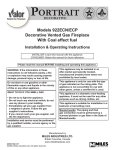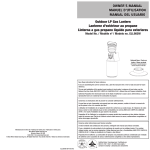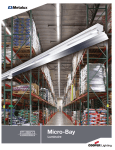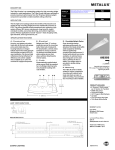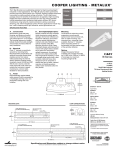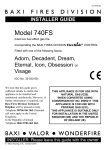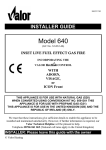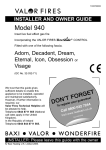Download Valor 922eCP Owner`s manual
Transcript
Model 922ECN ( Nat Gas ) Model 922ECP ( LP Gas ) Open Front Decorative Vented Gas Fireplace (With Coals) Installation and Owner’s Manual Please read this manual before installing and operating this heater This manual should remain with the homeowner WARNING: If the information in these instructions is not followed exactly, a fire or explosion may result causing property damage, personal injury or loss of life. - Do not store or use gasoline or other flammable vapors and liquids in the vicinity of this or any other appliance. -WHAT TO DO IF YOU SMELL GAS This appliance may be installed in an aftermarket permanently located, manufactured (mobile) home, where not prohibited by local codes. This appliance is only for use with the type of gas indicated on the rating plate. This appliance is not convertible for use with other gases, unless a certified kit is used. This appliance is a domestic room-heating appliance. It must not be used for any other purpose such as drying clothes etc. • • Do not try to light any appliance. Do not touch any electrical switch: do not use any phone in your building. • Immediately call your gas supplier from a neighbor’s phone. Follow the gas supplier’s instructions. • If you cannot reach your gas supplier, call the fire department. - Installation and service must be performed by a qualified installer, service agency or the gas supplier. This appliance is suitable for installation in a bedroom or bed sitting room. Warning: This product must be installed by a licensed plumber or gas fitter when installed within the Commonwealth of Massachusetts Manufactured by MILES INDUSTRIES LTD. British Columbia, Canada Vous pouvez vous procurer un exemplaire en langue Française de cette brochure chez votre marchand. 4000192/03 CONTENTS 1. 2. 3. 4. SAFETY INFORMATION ............................................................................................................................................................ 3 OPTIONS...................................................................................................................................................................................... 4 GENERAL DATA ......................................................................................................................................................................... 4 LOCATION IN THE ROOM ( insert application )………………………………………………………………………………… 5 ( Z.C Application )………………………………………………………………..…………6 5. SUPPLY GAS............................................................................................................................................................................... 7 6. PACK CONTENTS ...................................................................................................................................................................... 7 7. APPLIANCE PREPARATION..................................................................................................................................................... 8 8. GAS SUPPLY INSTALLATION .................................................................................................................................................. 9 9. FIREBOX INSTALLATION ....................................................................................................................................................... 10 10. REMOTE CONTROL INSTALLATION..................................................................................................................................... 11 11.1 CERAMIC WALLS INSTALLATION ........................................................................................................................................ 12 11.2.CERAMIC COALS INSTALLATION ........................................................................................................................................ 13 12. ADORN CAST FRONT INSTALLATION……………………………………………………………………………….…………14 13. WINDSOR CAST ARCH FRONT INSTALLATION ................................................................................................................. 15 14. OPERATION CHECKS.............................................................................................................................................................. 16 15. OWNERS INFORMATION ........................................................................................................................................................ 17 Lighting instructions ............................................................................................................................................................... 19 2 of 19 1. SAFETY INFORMATION Due to high temperatures, the appliance should be located out of traffic and away from furniture and draperies. Children and adults should be alerted to the hazards of high surface temperatures and should stay away to avoid burns or clothing ignition. Young children should be carefully supervised when they are in the same room as the appliance. Clothing or other flammable material should not be placed on or near the appliance. The safety guard must be put back in place prior to operating the appliance if it has been removed for servicing or cleaning. This appliance should be installed and repaired by a qualified service person. The appliance should be inspected before use and at least annually by a professional service person. More frequent cleaning may be required due to excessive lint from carpeting, bedding material, etc. It is imperative that control compartments; burners and circulating air passageways of the appliance are kept clean. If any changes are made to the room construction in the vicinity of the appliance after installation (e.g. additional mantle etc.) make sure that the changes conform to the installation requirements in this manual. Never attempt to burn paper or any other material in the appliance. This appliance must be properly connected to a venting system. The venting system should be checked periodically. Recent trends in home improvement and new tighter construction techniques have contributed to problems with venting. If you suspect that your appliance is not venting properly, do not operate. Seek expert advice. Do not use this appliance if any part has been under water. Immediately call a qualified service technician to inspect the appliance and to replace any part of the control system and any gas control, which has been under water. Only trim kits supplied by the manufacturer shall be used in the installation of this appliance. Draft openings must not be covered or blocked Keep curtains, clothing, furniture and other flammable materials a safe distance from all parts of the appliance Keep the appliance area well clear and free from combustible materials, gasoline and other flammable vapours and liquids. NOTE When operating your new fireplace for the first time, some vapors may be released due to the burning of curing compounds used in the manufacture of the appliance. They may cause a slight odor and could cause the flames to be the full height of the firebox, or even slightly higher, for the first few hours of operation. It is also possible that these vapors could set off any smoke detection alarms in the immediate vicinity. These vapors are quite normal on new appliances and are totally harmless. After a few hours use the vapors will have disappeared and the flames will be at their normal height. During the first hour of use the ceramic firebox walls may go a smoky color. This is not soot. It is a temporary effect lasting only while the ceramic material becomes stabilized. The walls will revert to their initial color after your fire has been used for one or two hours. 3 of 19 2. OPTIONS # 975 ZCK Zero Clearance Kit – for installation into combustible type framing. # 976 BRK Bedroom kit: Includes optional thermostat hand set and wiring harness (for use in Canada only) # 923 ACF Adorn Cast Front # 539 or 549 Windsor Cast Arch front. (also requires #540WDK Wire Dress Guard) # 3336 Closure Plate. For insert installations to cover up to 33” high x 36” wide 3. GENERAL DATA This appliance is certified for use in Canada and the USA under the following standards : ANSI Z21.50 – 2000 / CSA 2.22 –2000 , Vented Gas Fireplaces Can/CGA 2.17 – M91 Gas Fired Appliances for use at High Altitudes. This appliance must be installed in accordance with local codes, if any, or in the absence of local codes follow the National Fuel Gas Code ANSI Z223.1 or Canadian Installation Code CAN-1-B149. Only qualified licensed or trained personnel should install the appliance. 3.1 Venting This appliance must be connected to an approved venting system. 3.2 Ratings 922ECN Altitude (Ft) Input Max. (Btu/h) Input Min (Btu/h) Manifold pressure (in w.c.) Max Supply pressure (in w.c) Min. Supply pressure (in. w.c.) 922ECP 0-4500 20,500 12,000 3.7 10.5 5 19,000 12,500 10.5 13 11 3.3 Choice of Cast Iron Front Trims 923 Adorn 539 Windsor Arch w/ Plate 549 Windsor Arch w/o Plate Note : the 539/549 Fronts require a 540 WDK Wire Dress Guard with the 922 heater. Cast Iron Tolerances – Due to the nature of Cast Iron, dimensional consistency may vary from one unit to the next and some variation in surface finish and flatness is to be expected. We have done our best to control and make allowance, however some variation is inevitable. Closure plates may be required for insert applications where cast fronts do not cover entire openings. Standard black 33” high x 36” wide closure plate with black aluminum extrusion edge is available. 4 of 19 4. LOCATION IN THE ROOM This appliance must not be connected to a chimney flue serving a separate solid-fuel burning appliance. Note: The State of Massachusetts requires that any flue damper must be removed or permanently welded in the open position. The appliance can be installed in the following constructions: 4.1 Solid fuel (Non-combustible) fireplaces As supplied, this appliance can be installed as an inset in an existing solid fuel type fireplace with a chimney and 4" dia liner (see fig.1). The fireplace must be built in accordance with the national, state provincial or territorial building code recognised by the authority having jurisdiction, or in the absence of such a code, in accordance with the National Building Code of Canada or the National Fire Protection Association code in the USA The size of the fireplace recess must be sufficient to accommodate the appliance as shown in fig.1. If previously used with for burning solid-fuel, the chimney must be swept before installation of the appliance. Both chimney and fireplace must be checked for soundness before installation of the appliance. The liner must be a type approved by the enforcing authority and installed in accordance with the manufacturer's instructions. The appliance must be installed on a floor, which is sufficiently flat and level to ensure stability. Some fireplace constructions have a well in the floor at the back that may need to be filled in. Though not mandatory, we recommend that carpet, soft vinyl or other combustible floor coverings are kept at least 16” from the front of the appliance since these types of materials may be affected by the radiant heat output from this appliance. The minimum clearances from any combustible constructions at the front of the appliance are shown in fig.2 The appliance must be connected to a vent that is a minimum of 9’-0” in height and must not have any 90 deg. elbows within 9’-0” of the flue outlet of the unit (see fig. 1). Radiused offsets in the flue liner of less than 90 degrees are permitted. Fig 1 . Insert Box dimensions and insert venting Fig. 2 Clearances to combustible materials in front of opening - All installations 5 of 19 4.2 Enclosures Constructed Using Combustible Materials ( Z.C Installations) Optional # 975 ZCK zero clearance kit must be used when installing the 922 Fireplace into any application other than as an insert into an approved solid fuel burning fireplace cavity and chimney. Complete installation instructions are packed with the 975 ZCK. See fig 2 for clearances in front of appliance. The 975 ZCK is approved for installation directly on combustible type flooring such as plywood. Bottom of 975 must be installed at top of finished hearth (including tile etc.) or the removable ashpan cover will not rest at the proper height. Cast iron fronts must also rest on a secure hearth or floor as the unit is not intended to carry the weight of the castings. The 975 ZCK may be roughed-in, wall finishes applied , and the fireplace installed at a later date or the fireplace and Z.C kit may be installed at the same time. 975 ZCK Assembled 975 ZCK Components 975 ZCK installed into Framing Framing Dimensions 975 ZCK Wall Finish Details 6 of 19 5. SUPPLY GAS Model 922ECN is for use only with natural gas. Model 922ECP is for use only with propane gas. The supply pressure must be between the limits shown in section 3 of this manual. The supply connection is 3/8”NPT male thread. The supply pipe connection is to a flexible connector at the left hand side of the appliance. 6. PACK CONTENTS This appliance requires more than one pack to complete the installation. The firebox unit is packaged separate from the front trim. There is a choice of front trims to fit this unit (see section 3 of this manual). A 975 ZCK Zero Clearance Kit is required when installing this appliance into any application other than as an insert into an approved solid fuel burning fireplace. 922 - Firebox Unit contains: 1 1 1 1 2 3 1 1 1 1 4 1 Burner & box Unit Ceramic Wall Pack Coal support Coal pack Wall plugs Screws Flue spigot assembly Remote control unit (including the following) Receiver unit Remote control hand unit 1.5V AA Batteries 9V Battery One of the Optional front trims below must be used with this appliance ( see section 3 for diagrams) 923 - “Adorn” Cast Front: (comes complete with wire guard ) 539 “Windsor Arch” cast front with back plate ( requires 540WDK wire guard when used with 922 firebox ) 549 “ Windsor Arch “ cast front without back plate. ( requires 540 WDK wire guard when used with 922 firebox) Note - The 540 WDK consists of a wire guard and mounting hardware as the Windsor Arch is not supplied with a wire guard. Both the 539 and 549 Windsor Arch fronts are packaged with some redundant mounting hardware as they also fit other models of fireboxes. Take care when removing the contents from the packaging to prevent damage. Check that all the contents are in the packs and are undamaged. Take special care in handling the ceramic walls and the coals. 7 of 19 7. APPLIANCE PREPARATION 7.1. Check ignition spark The pilot burner and electrode unit is at the left end of the burner. Push in the lighting knob and turn counter-clockwise through the “IGN” position to “PILOT”. A spark should flash across from the pilot electrode to the pilot burner shield. See figure 3. 7.2 Aeration Setting Check The burner is equipped with an adjustable shutter to control primary aeration. See figure 4. The shutter is factory set at an aeration gap, which will give optimum performance for the vast majority of installations. In a few unusual installations performance may be improved by adjusting the aeration. The need for adjustment should be determined by operating the appliance with the ceramic fuel effects and window installed. See the “Final checks” section in this manual for adjustment details. The shutter setting is very critical. A small change can make a substantial difference to the performance. Figure 3 7.3 Install Base Coal Support Install base coal support ( packed loose ) to back of firebox using 3 screws as shown in fig 5 . Fig 5 Figure 4 7.3 Remove Burner Module (optional) In some cases, to make gas piping easier, it may be convenient to remove the burner module from the firebox, see fig 6 (note the location of the gas inlet before removing the burner module). Remove 2 screws and pull the burner module partially out of the firebox taking care not to pull on the wire leads going to vent switch. With the module partly removed, reach behind the module with a wrench and loosen the thermocouple nut at the back of the valve. With the thermocouple nut loose, pull the vent switch wire leads out of the brass block at the back of the valve and pull the burner module the rest of the way out of the firebox. Rough-in the gas line, valves, or unions and reinstall the burner module. Fig 6 8 of 19 8. GAS SUPPLY INSTALLATION 1. The appliance is supplied for supply gas connection at the left hand side of the case. There is also a gas line access at he rear of the firebox for insert applications, see fig 7.The zero clearance kit does not have access at the rear. Supply line connection to the flexible adapter is 3 /8”NPT male thread. Alternatively, the appliance inlet pipe may be removed and the supply line routed directly to the control unit. An isolating valve could be fitted within the appliance case. 2. Use only new black iron or steel pipes or copper tubing if acceptable - check local codes. Note that in USA copper tubing must be internally tinned for protection against sulfur compounds. 3. Ensure there is a pipe union (or flare fitting where permissible) ahead of the burner module for future servicing. Unions in gas lines should be of ground joint type. 4. The gas supply line must be sized and installed to provide a supply of gas sufficient to meet the maximum demand of the appliance without undue loss of pressure. Fig 7 5. Sealant used must be resistant to the action of all gas constituents including LP gas. Sealant should be applied lightly to male threads to ensure excess sealant does not enter gas lines. 6. The supply line should include a manual shut-off valve to allow the appliance to be disconnected for servicing. A plugged 1/8”NPT tapping must be installed in the line. The tapping must be accessible for test gauge connection and be immediately upstream of the gas supply connection to the appliance. 7. Pressure test the supply line for leaks. • The appliance and its individual shut-off valve must be disconnected from the gas supply piping system during any pressure testing of that system at test pressures in excess of ½psig (3.5kPa). • The appliance must be isolated from the gas supply piping system by closing its individual manual shut-off valve during any pressure testing of the gas supply piping system at test pressures equal to or less than ½psig (3.5kPa). • Failure to either disconnect or isolate the appliance during pressure testing may result in regulator or valve damage. Consult your dealer in this case. 8. The minimum supply pressure is given in section 3 of this manual. 9. All piping and connections must be tested for leaks after installation or servicing. All leaks must be corrected immediately. When testing for leaks: • Make sure that the appliance is turned off. • Open the manual shut-off valve. • Test for leaks by applying a liquid detergent or soap solution to all joints. Bubbles forming indicate a gas leak. Never use an open flame to check for leaks. Correct any leak detected immediately. 10. The pressure test tapping locations are shown in figure 8 . A built-in regulator controls the burner manifold pressure. The correct pressure range is shown in the table in section 3 of this manual. The pressure check should be made with the burner alight and the input set to its highest setting. See lighting instruction section for full operating details. Figure 8 9 of 19 9. FIREBOX INSTALLATION ( insert Application only ) 9.1 Refer to 975 ZCK installation Manual for Z.C Firebox installation. 9.2 To aid chimney liner connection it may be necessary to first remove the vent collar connector from the top of the firebox ( see fig 9a ) 9.3 Remove the burner module from the firebox, see fig 9 . 9.4 Insert the convection box into the fireplace opening feeding the supply pipe through hole at back or side of the firebox see section 8. 9.5 Mark the fireplace floor through the two slots in the base of the convection box (see figure 9 ) and remove the convection box. Drill two holes in the fireplace floor at the marked positions using a no.12 masonry drill. 9.6 Insert a wall plug into each hole. 9.7 Secure the collar on the vent connector unit to the 4" diameter chimney liner. 9.8 Slide the firebox into the fireplace making sure that the vent connection unit is above the convection box. Leave the firebox front a few inches clear of the fireplace front to allow you to fix the vent connector to the top of the firebox. 9.9 With the vent connector started in the cleat pull the vent connector towards the front of the fireplace. Fix the front of the vent connector plate to the firebox front flange using the screw previously removed (Fig 9a.). 9.10 Push the convection box fully home against the front face of the fireplace. Make sure that no sags or dips occur in the liner. 9.11 Fit a woodscrew through each slot in the convection box base and tighten. 9.12 Re-install the burner module and connect the gas supply line to the module ( see section 8 ) Fig 9 , Remove Burner Module and fasten firebox. Fig 9a, Removing Vent Connector Plate. 10 of 19 10. REMOTE CONTROL INSTALLATION Caution! Don’t connect the batteries to the remote control receiver until the wires are connected to the burner control unit, as short circuit could result in destruction of the electrical components. When installing the remote please refer to figures 10 and 11. • • • • • • Connect the wiring harness to the receiver box, by pushing the wire connector on to the receiver circuit board. The plug will only go on one way so please ensure that the wires are pointing up and slot in the board is inline with the tab on the wiring harness plug, see fig 11. Connect wires as shown in fig 11 - Please note that the connectors are different sizes, the smaller one fits to the lower connection on the valve. Remove the remote control receiver lid. Fit four 1.5V batteries. Place the remote control receiver on the “Velcro” pad, see fig 10. Fit the 9V battery to the handset transmitter Remote control operating instructions are on page 17 of this manual and are supplied with the remote control kit. Figure 10 Figure 11 Valve connections 11 of 19 11. CERAMIC FUEL BED INSTALLATION 11.1. Ceramic Walls Installation 1. Locate the ceramic rear wall on top of the base coal support as shown in fig 12. 2. Insert the right hand sidewall at approx 30 degree angle between the firebox side and the burner. Swing the top of the sidewall to the vertical position and locate behind the upper baffle (see fig13). 3. Repeat step 2 with left hand sidewall (Fig 13) Fig 12 Back Brick Installation Fig 13 Side Brick Installation 12 of 19 11.2. Ceramic Coals Installation 1. Rest the base coal on the supports just behind the burner and let it rest against the base coal support at the back of the firebox. See fig 14. 2. Place the left front coal in position behind the metal lip at the front of the firebox. The side projection on this coal should be near the middle front of the firebox. See figure15 . 3. Place the right front coal behind the metal lip at the front of the firebox. Its left side should rest over the projection on the left front coal. See figure 16 . 4. The center right coal has letter “R” embossed underneath. Place this coal behind the front right coal. See figure 17 . 5. The center left coal has letter “L” embossed underneath. Place this coal behind the front left coal. See figure 18 . Figure 16 Figure 15 Figure 14 Figure 17 Figure 18 13 of 19 12. #923 ADORN CAST FRONT INSTALLATION 12.1 Carefully lift the casting. Place it against the fireplace front surface so that the retaining strip at the back of the casting is above the two upper retaining brackets at the top of the convection box. Lower the casting making sure that the rear retaining strip locates fully over the retaining brackets on the convection box (See figure 19). 12.3 Slide the front casting/surround sideways, if necessary, to align the bottom fixing holes with those in the convection box. Fix the bottom of the casting/surround to the convection box with two screws (See figure 20). Fig. 20 “Adorn” Front casting bottom fixing Fig. 19 “Adorn” front casting top location 13. 13.1 ADORN SAFETY GUARD FITTING Locate the guard bottom wires over the brass ash lip. Hold the top springs down. Swing the guard back. Release the springs so that they locate behind the canopy (See figures 22 and 23). Figure 21 Fitting “Adorn” safety guard Fig 22 14 of 19 14. #539/549 WINDSOR ARCH CAST FRONT INSTALLATION 14.1 All Windsor Arch fronts mounted to 922 fireboxes require a 540 WDK wireguard and mounting hardware, see fig 23. Note – Bottom of Firebox must be installed flush with the finished hearth height or casting will not install properly. Castings must rest on secure hearth or floor as the firebox and brackets will not support castings on their own 14.2 Install mounting brackets and burner tray cover to the firebox ( see fig 24) 14.3 Install black Canopy Shield to cover openings in cast iron canopy ( see fig 25 ). Lay inner cast front face down on the floor. Insert one corner of the shield into the corner behind the cast frame as shown. Bend the canopy shield to a slight Fig 23 , 540 WDK Components radius while inserting the other corner behind the cast frame as shown ( it may be necessary to loosen or remove one or two of the canopy bolts). With both corners behind the cast frame, snap the shield forward to follow the curve of the cast iron canopy. The top of the shield should fit under the projecting ledge in the casting as shown. 14.4 Fasten top filler piece to back side of Cast Arch ( see fig 26 ) 14.5 Mount cast arch to brackets on firebox as shown in fig 27. 14.6 Hang inner casting on the outer arch and install wireguard as shown in fig 27. Fig 24 , bracket and burner tray cover installation Fig 25 ,Canopy Shield Installation Fig 26 , Top filler installation Fig 27 , Mounting Cast Arch to Firebox. 15 of 19 15. OPERATION CHECKS 1. Check ignition, pilot stability, burner flames, and the full range of movement of the flame adjustment knob. See owner’s lighting instructions further on in this manual for full details, see fig 28. 2. Aeration adjustment As described in section 17, burner aeration is adjustable. For the vast majority of installations, no adjustment will be necessary. However, in a very few instances, performance may be improved by adjusting the aeration by sliding the shutter (See figure 4 page 8). Evaluate the aeration only after the unit has warmed up – approximately 15 minutes. The shutter setting is very sensitive. Small adjustments can make a substantial difference to the flames Fig 28, Pilot Flame location Increasing aeration will cause the flame to appear more transparent and blue making the ceramic fuel effects glow more. Decreasing aeration will cause the flames to appear more yellow or orange making the fuel effects glow less. Too little aeration may result in black carbon forming and dropping into the firebox. 3. Check venting efficiency 3.1 A check for correct venting of combustion products must be made before the installed appliance is left with the customer. You will need a mirror for this check. 3.2 The mirror must be cold and dry for the check so keep in a cool place such as a freezer compartment.y while the fire is warming up. 3.4 Open the gas valve. 3.5 Light the appliance and set to high heat.Leave the appliance on for five minutes. 3.6 Make sure that the mirror is cold and dry. Place the mirror face downwards touching the bottom front of the black cross member and angled slightly upwards so that the mirror face can be seen.(see fig 29) 3.7 The mirror face should remain clear for at least 5 seconds. If condensation appears over the mirror face within 5 seconds the venting is not functioning properly. Don’t allow the appliance to be used until the problem is cured. Fig.29 Venting check with mirror (Shown with “Adorn” front) 16 of 19 16. OWNERS INFORMATION Please read the safety information and notes on page 3. 16.1. Operating Your Fire The operating instructions are also on a chained plate inside the control access door. 1. For your safety this appliance is fitted with a flame supervision device which will shut off the gas supply if, for any reason, the pilot flames go out. This device incorporates a fixed probe, which senses the heat from the pilot flame. If the probe is cool, the device will prevent any gas flow unless the burner control knob is kept pushed in at the PILOT position. See full lighting instructions on next page. 2. The Valor Remote Control System Your Valor Remote Control helps you get the comfort, convenience and aesthetics you want from your Valor Gas Fireplace. Setting the Flame a. Press either of the large “up” or “down” buttons. b. To raise the flame, press and hold the “up” button until you come to the flame level you want. Let go. c. To lower the flame, press and hold the down button until you come to the flame you want. Let go. d. The flame level will remain just as you set it. 3.When first turned on, the decorative flames will appear predominantly blue. After approximately 15 minutes the flames will turn yellow. 16.2. Cleaning Turn the fire off and allow it to cool before attempting any cleaning. Note that the fire will retain heat for some time after it has been turned off. Metal parts Clean the metal parts with a slightly damp cloth and then dry. Do not use abrasive cleaners, they could scratch the surface. Coals and ceramic firebox walls Dust etc. Can be brushed from the coals using a soft bristle paintbrush after removing the safety guard. We suggest that you remove the coals in the reverse order to that shown in fitting instructions. Make sure that no particles are brushed into the ceramic burner slots. 17 of 19 16.3. Checks 1. A periodic check of the pilot and burner flames should be made. Check after the fire has been on for at least 30 minutes. The pilot flame must cover the tip of the thermocouple probe. The main burner flame pattern will vary from appliance to appliance depending on the type of installation and climatic conditions. See figures 30 and 31 2. The appliance area must always be kept clear and free from combustible materials, gasoline and other flammable vapors and liquids. 3. Inspect the vent terminal outdoors regularly to make sure there are no obstructions from birds nests, insects or rodents, etc. 4. Examine the whole vent system regularly. We recommend annually. 16.4. Servicing All appliances use four 1.5V AA batteries for thermostat control. The batteries used in the remote control receiver are accessible by opening the bottom access panel and removing the lid of the remote control receiver. The handset has a 9V battery. Figure 30 16.5. General servicing If you require any attention to your appliance, contact your supplier quoting the model number. It will be helpful if the appliance serial number can also be quoted. This is on the rating plate, which is on a chained, plate accessible by opening the bottom access panel. The repair parts are shown in the separate repair parts leaflet. Please always quote part number and description when requesting spare parts. Figure 31 18 of 19 YOUR SAFETY READ BEFORE LIGHTING WARNING: If you do not follow these instructions exactly, a fire or explosion may result causing property damage, personal injury or loss of life. A. This appliance has a pilot, which must be lighted by hand. When lighting the pilot, follow these instructions exactly. B. BEFORE LIGHTING smell all around the appliance area for gas. Be sure to smell next to the floor because some gas is heavier than air and will settle on the floor. WHAT TO DO IF YOU SMELL GAS • Do not try to light any appliance. • Do not touch any electric switch; do not use any phone in your building. • Immediately call your gas supplier from a neighbor’s phone. Follow the gas supplier’s instructions. • If you cannot reach your gas supplier, call the fire department. C. Use only your hand to push in or turn the control knobs. Never use tools. If the controls will not push in or turn by hand, don’t try to repair them, call a qualified service technician. Force or attempted repair may result in a fire or explosion. D. Do not use this appliance if any part has been under water. Immediately call a qualified service technician to inspect the appliance and to replace any part of the control system and any gas control, which has been under water. LIGHTING INSTRUCTIONS 1. STOP! Read the safety information above. 2. Set the flame adjustment knob as far clockwise as possible*. to OFF. 3. Turn the gas control knob clockwise NOTE: The knob cannot be turned from PILOT to OFF unless it is pushed in partially. Do not force. 4. Wait five (5) minutes to clear out any gas, then smell for gas, including near the floor. If you smell gas, Flame STOP! Follow “B” in the safety information above. If Adjustment you don’t smell gas, go to the next step. Knob 5. Find the pilot. It is at the left side of the firebox viewed through hole in front log. 6. Push in and turn the gas control knob counterclockwise until resistance is felt just before the “IGN” position. 7. Keep pushed in for a few seconds to allow gas to flow then, keeping knob depressed, turn to “PILOT” to light pilot. Hold knob in for a further 5 seconds then release. The knob should pop back out. Pilot should remain lit. If pilot goes out repeat steps 3 through 7. • If knob does not pop out when released, stop and immediately call your service technician or gas supplier. • If pilot lights but will not stay lit after several tries, turn the gas control knob to “OFF” and call your service technician or gas supplier. 8. When pilot is lit, partially depress the knob and turn to “ON” position (Burner alight). • Do not leave knob set between “PILOT” and “ON”. 9. Set the flame height to desired setting*. TO TURN OFF GAS TO APPLIANCE as possible* 1. Set the flame adjustment knob as far clockwise 2. Push in gas control knob slightly and turn clockwise to “OFF”. Do not force. * The flame height can be increased or decreased by depressing the remote control hand set button. 19 of 19




















